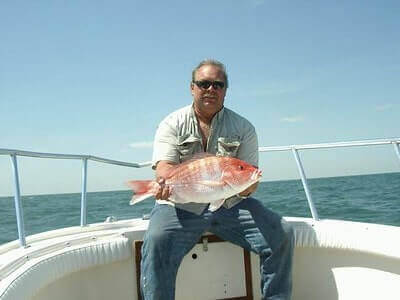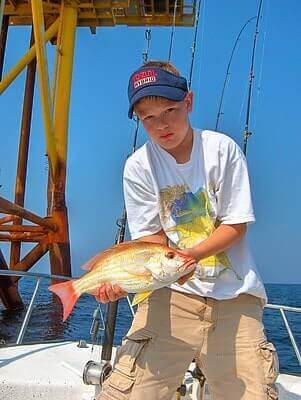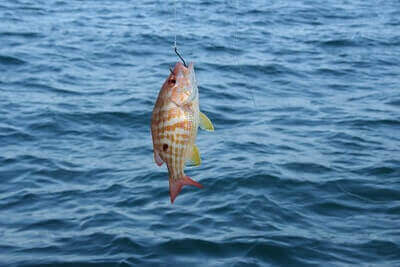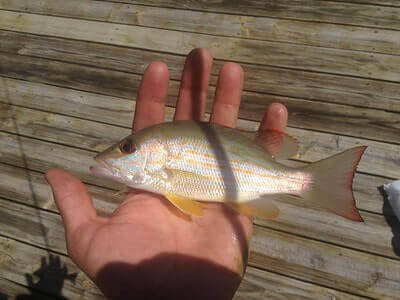Disclosure: We may earn commissions if you purchase products after clicking on a link from our site.
Are you interested in learning how to catch lane snapper? They are found in the western Atlantic Ocean, from North Carolina to the south of Brazil. The Florida Keys, Puerto Rico, and the U. S. Gulf of Mexico are locations where you can find lane snapper.
Lane snappers (Lutjanus synagris) are aggressive and will put up a hard fight when caught. In this article, we discuss how to catch lane snapper, the bait and lure used by anglers when fishing for lane snapper, as well as tips and tricks to help you take many of these tasty fish home. Lane snappers can be found in deeper reefs and hard bottoms.

Table of Contents
How To Catch Lane Snapper
Lane snappers are aggressive and will put up a fight when hooked. They are often found in shallow waters over coral reefs, ledges and hard bottom areas, and sandy areas with vegetation. They can also be found deep in the water column and at the bottom where they feed.
Lane snappers grow to about 14 inches in length, although you can find some that are as large as 20 inches. Lane snappers will not weigh more than 7 pounds. A simple chicken rig with shrimp or cut bait will work for lane snapper.
Lane snapper can be found all along the Florida coast. You can find them in coral reefs, and sandy and rocky areas. They are seen in shallow waters and offshore waters. When fishing for lane snapper off Florida’s coast, anglers use baitcasting, bottom fishing, trolling, jigging, night fishing, and drift fishing. The Florida size limit for lane snapper is 8 inches.
1. Bottom Fishing
Bottom fishing is one of the most common and effective methods for catching lane snapper. Anglers typically use a variety of bait such as squid, shrimp, or cut fish presented on a hook attached to a leader and weighted rig.
By targeting rocky reefs, ledges, and underwater structures where lane snapper congregate, anglers can drop their baited rigs to the bottom and wait for a bite. Once a bite is detected, anglers can set the hook and reel in their catch. It’s essential to use appropriate tackle and gear to handle the strong and agile lane snapper.
Anglers should also consult the website of the National Oceanic and Atmospheric Administration for information on fishing regulations and guidelines to ensure responsible angling practices.
2. Drift Fishing
Drift fishing is another effective method for targeting lane snapper, especially when fishing over expansive reef systems or areas with strong currents. Anglers can drift along these areas while presenting baited rigs to the snapper below.
This method allows anglers to cover a large area and locate active feeding lanes where lane snappers are likely to be found. Using baits such as squid, shrimp, or small fish, anglers can entice lane snapper to strike as they drift with the current. Properly rigged tackle and sensitive rods are essential for detecting subtle bites while drift fishing for lane snapper.
Anglers should also adhere to fishing regulations and conservation measures outlined by NOAA.gov to protect the fishery and ensure sustainability.
3. Baitcasting
Baitcasting is a versatile fishing method for targeting lane snapper, offering anglers precision and control when presenting baits in precise locations such as around rocky structures or underwater ledges where lane snapper often congregate.
Anglers using baitcasting reels can employ a variety of baited rigs, including bottom rigs, Carolina rigs, or drop-shot rigs, to present baits such as squid, shrimp, or cut fish to the snapper below. The key to successful baitcasting for lane snappers lies in accurate casting and bait presentation.
Anglers should use a suitable rod and reel combo matched to the weight of their bait and fishing conditions. By adjusting the casting distance and trajectory, anglers can place their bait precisely where the lane snapper is feeding, increasing their chances of a bite. Anglers must monitor their bait closely and be ready to detect subtle bites, as lane snapper can be cautious and may not always take the bait aggressively.

4. Trolling
Trolling can be an effective method for targeting lane snapper, particularly when fishing along offshore structures or drop-offs. Anglers can deploy trolling rigs equipped with artificial lures or baited hooks at various depths behind a slow-moving boat. By covering a large area while trolling, anglers can locate schools of lane snapper and trigger strikes from feeding fish.
Using lures that mimic small baitfish or squid can be particularly effective when trolling for lane snapper. Anglers should adjust their trolling speed and lure depth based on water conditions and the behavior of the fish. Before trolling for lane snapper, anglers should familiarize themselves with any regulations or guidelines provided by NOAA.gov to ensure responsible fishing practices.
5. Night Fishing
Night fishing for lane snapper can be an effective strategy, as these fish are known to be more active during low-light conditions. Anglers often find success targeting lane snapper after sunset or before sunrise when they are actively foraging for food.
During the night, lane snapper may move closer to the shorelines or congregate around underwater structures such as reefs, wrecks, or rock formations. Anglers can use a variety of baits such as squid, shrimp, or small fish to entice lane snapper during nocturnal fishing trips.
Additionally, deploying lighted bobbers or glow-in-the-dark lures can help attract lane snappers in dark waters. Anglers need to exercise caution and ensure they have proper lighting and safety equipment when night fishing.
6. Jigging
Jigging is a popular fishing technique for targeting lane snapper, especially around offshore structures such as reefs, wrecks, and rock ledges where these fish often congregate. To catch lane snapper using jigging, anglers typically use specialized jigs designed to mimic the movement of small baitfish or crustaceans, which are among the preferred prey of lane snapper.
Anglers drop the jig down to the desired depth, typically near the bottom where lane snapper tends to feed, and then impart action to the jig by twitching the rod tip or jigging it up and down. This motion creates an enticing presentation that can trigger strikes from hungry lane snappers.
Successful jigging for lane snapper requires patience, as anglers may need to experiment with different jigging techniques, depths, and jig colors to find what works best on any given day. It’s crucial to pay attention to subtle bites and strikes, as lane snappers can be finicky feeders. Additionally, anglers should be mindful of local fishing regulations and conservation practices to ensure the sustainable harvesting of lane snapper populations.
7. Still Fishing
Still fishing, also known as bottom fishing, is an effective technique for targeting lane snapper, particularly in areas with structures such as reefs, wrecks, and rock piles. To catch lane snapper using still fishing, anglers anchor their boats near productive spots and deploy baits directly to the bottom where lane snapper often forage.
Common baits for still fishing include squid, shrimp, cut bait, and small fish such as pilchards or sardines. Anglers can rig their baits on a variety of bottom rigs, such as a fish finder rig or a chicken rig, which allow the bait to sit naturally on the seabed while minimizing snags.
Once the bait is in place, anglers wait patiently for bites, occasionally adjusting the bait presentation or repositioning the boat if necessary. Still fishing requires attention to detail, as anglers must monitor rod tips for subtle bites and be ready to set the hook quickly when a lane snapper takes the bait.
It’s essential to use appropriate tackle and line strength to handle the potential size of lane snappers and the structure they inhabit. Anglers should also be aware of local fishing regulations and practice responsible fishing techniques to ensure the sustainability of lane snapper populations. For more information on fishing regulations and best practices, anglers can consult resources provided by the National Oceanic and Atmospheric Administration (NOAA) Fisheries.

8. Vertical Jigging
Vertical jigging is a versatile technique that can be effective for catching lane snapper, particularly when fishing near submerged structures or wrecks. Anglers can use heavy metal jigs designed to imitate baitfish or squid, which are dropped vertically and jigged up and down through the water column.
Lane snappers are known to suspend above the bottom, making them susceptible to this method. Anglers can vary their jigging cadence and depth to trigger strikes from feeding snapper. It’s essential to use high-quality jigs and sturdy tackle to handle the strong runs and headshakes of lane snapper.
9. Chumming
Chumming can be an effective strategy for attracting lane snapper to the fishing area and stimulating their feeding behavior. Anglers can use a mixture of ground-up baitfish, fish parts, and other natural attractants to create a scent trail in the water.
By dispersing the chum around the boat or fishing spot, anglers can draw in hungry lane snapper from nearby areas. Once the snapper is actively feeding, anglers can present baited rigs or lures to entice strikes. It’s essential to use chum responsibly and avoid overfeeding to prevent negative impacts on the marine environment.
Anglers should also check NOAA.gov for any regulations or restrictions regarding chumming in their fishing location.
10. Live Bait Fishing
Live bait fishing can be highly effective for targeting lane snapper, especially when presenting natural baits such as live shrimp, pinfish, or small baitfish. Anglers can use a variety of rigs, including Carolina rigs or drop-shot rigs, to present live bait near the bottom or suspended in the water column.
By allowing live bait to swim naturally, anglers can attract the attention of nearby lane snapper and elicit strikes. It’s essential to use appropriate tackle and gear to handle live bait and the strong fighting ability of lane snapper.
Lane Snapper Fishing Tackle
Lane snapper doesn’t grow into a very large fish. its average length is about 14 inches and weighs about 7 lbs maximum. A light tackle will work well when fishing for lane snapper.
Best Baits For Lane Snapper
- Shrimp
Shrimp is a highly effective bait for targeting lane snapper, offering both scent and visual appeal to entice these fish. To catch lane snapper using shrimp, anglers typically rig the shrimp on a hook, either whole or in pieces, depending on the size of the bait and the preferences of the fish.
Using a bottom rig like a fish finder rig or a Carolina rig is common, allowing the bait to rest on the seafloor where lane snapper often forage. Anglers can also add a small piece of weight to ensure the bait stays near the bottom, where lane snapper is commonly found around reefs, wrecks, and other structures.
Once the bait is rigged and deployed, anglers should pay close attention to their rod tips for any signs of bites. Lane snapper bites can sometimes be subtle, so it’s essential to be attentive and ready to set the hook at the slightest indication of a nibble. Anglers should use appropriate tackle and line strength to handle the potential size of lane snappers and the structure they inhabit.
Additionally, it’s crucial to follow local fishing regulations and practice responsible angling techniques to ensure the sustainability of lane snapper populations. For more information on fishing regulations and best practices, anglers can consult resources provided by the National Oceanic and Atmospheric Administration (NOAA) Fisheries.
2. Crabs
Crabs are a natural and enticing bait option for anglers targeting lane snapper. These crustaceans are a favorite food source for lane snapper, making them an effective choice for enticing bites. To catch lane snapper using crabs as bait, anglers typically rig the crab onto a hook, either whole or in pieces depending on the size of the bait and the preferences of the fish.
Using a bottom rig such as a fish finder rig or a Carolina rig is common practice, allowing the crab bait to rest on the seafloor where lane snapper frequently forages around reefs, wrecks, and other underwater structures. Anglers can also add a small piece of weight to keep the bait near the bottom and within the strike zone of the fish.
Once the bait is deployed, anglers should monitor their rod tips closely for any signs of bites, as lane snapper strikes can sometimes be subtle. It’s essential to remain attentive and ready to set the hook at the slightest indication of activity.
Anglers should use appropriate tackle and line strength to handle the potential size of lane snappers and the structure they inhabit. Additionally, following local fishing regulations and practicing responsible angling techniques are crucial to the sustainability of lane snapper populations.
3. Mollusks
Mollusks, such as clams, mussels, and squid, are effective bait options for targeting lane snapper. These invertebrates emit natural scents and flavors that attract lane snapper, making them a popular choice among anglers.
To use mollusks as bait for catching lane snapper, anglers typically rig them onto a hook using a variety of techniques. For example, clams and mussels can be threaded onto a hook whole or in smaller pieces, while squid can be cut into strips or used whole depending on the size of the bait and the preferences of the fish.
Anglers may also opt to use specialized rigs such as high-low rigs or dropper loop rigs to present the bait effectively to the fish. It’s essential to ensure that the bait is securely attached to the hook to prevent it from being easily stripped off by smaller fish or strong currents.
Once the bait is deployed, anglers should monitor their lines closely for any signs of bites. Lane snapper strikes can sometimes be subtle, so it’s crucial to remain attentive and ready to set the hook at the slightest indication of activity.
Anglers should use appropriate tackle and line strength to handle the potential size of lane snappers and the structure they inhabit. Additionally, following local fishing regulations and practicing responsible angling techniques are essential to the sustainability of lane snapper populations. For more information on fishing regulations and best practices, anglers can consult resources provided by the National Oceanic and Atmospheric Administration (NOAA) Fisheries.
4. Small fish
Small fish, such as pilchards, pinfish, and sardines, serve as excellent bait options for targeting lane snapper. These baitfish emit natural scents and vibrations that attract lane snapper, enticing them to bite. Anglers can catch small fish using various methods, including casting nets, sabiki rigs, or hook-and-line techniques.
Once caught, anglers typically rig the small fish onto a hook using methods like live-lining or butterfly jigging to mimic natural movement in the water. It’s crucial to match the size of the baitfish to the size of the target species and adjust the hook size accordingly to ensure a natural presentation.
When targeting lane snapper, anglers should focus on fishing near structures such as reefs, wrecks, or ledges where these fish are known to congregate. Properly presenting the bait around these structures increases the chances of attracting lane snapper. Anglers should monitor their lines closely for any signs of bites, which can sometimes be subtle.
It’s essential to maintain a sensitive touch and be prepared to set the hook quickly when a fish takes the bait. As with any fishing activity, anglers should follow local regulations and guidelines to ensure sustainable fishing practices.

Best Lures For Lane Snapper
- Jigs
Jigs are highly effective lures for targeting lane snappers, offering anglers versatility and control over presentation. These artificial baits come in various shapes, sizes, and colors, allowing anglers to match the hatch and mimic the prey species preferred by lane snapper.
To catch lane snappers using jigs, anglers typically deploy a vertical jigging technique. This involves dropping the jig to the desired depth near structures such as reefs, wrecks, or ledges where lane snappers are known to inhabit.
Anglers then impart action to the jig by jerking or jigging the rod tip, causing the lure to dart and flutter enticingly in the water column. This motion imitates the erratic movements of injured or fleeing baitfish, triggering predatory instincts in lane snapper.
Successful jigging for lane snappers requires precise coordination and timing to mimic the natural movements of their prey. Anglers should experiment with different jigging cadences and retrieve speeds to determine what triggers strikes from the fish. It’s essential to use jigs that closely resemble the size and color of the baitfish prevalent in the area.
Additionally, anglers should choose jigs with quality hooks that can withstand the powerful strikes of lane snapper. By mastering the art of jigging and understanding the behavior of lane snapper, anglers can increase their chances of success when targeting these prized gamefish.
2. Flies
Flies can be effective lures for targeting lane snapper, particularly in shallow water or when the fish are feeding near the surface. Anglers often use fly fishing techniques to present these artificial imitations of baitfish, shrimp, or other prey species to entice lane snapper strikes.
To catch lane snapper using flies, anglers typically employ sight-fishing or casting techniques in areas where lane snapper are known to frequent, such as reefs, wrecks, or mangrove edges. When sight-fishing, anglers look for signs of feeding activity or the presence of lane snapper schools and then carefully cast their flies to target individual fish.
Alternatively, anglers can blind cast their flies into likely holding areas and then employ a variety of retrieval techniques to mimic the movements of natural prey. Fly selection is crucial when targeting lane snapper, with anglers opting for patterns that closely resemble the baitfish or crustaceans present in the area.
It’s essential to match the size, color, and action of the fly to the prevailing conditions and the preferences of the fish. Successful fly fishing for lane snapper requires patience, precision casting, and keen observation of fish behavior. Anglers should also be mindful of local regulations and conservation measures to ensure sustainable fishing practices.
Lane Snapper Recipes
This is a good recipe to prepare lane snapper.
Snapper Almondine
Ingredients:
- 4 (6 oz.) snapper filets
- 2 teaspoons cayenne pepper
- sea salt, to taste
- ground black pepper, to taste
- 1 cup rice flour
- ¼ cup butter, Crisco, Olive Oil, or Vegetable Oil
- ½ cup sliced almonds
- ¼ cup lemon juice
- ¼ teaspoon flat-leaf parsley, chopped
- parsley or rosemary for garnish, optional
How To Cook Lane Snapper:
Fillet the lane snapper
Coat it with flour by placing it in a bowl with flour. Turn it over a couple of times in the bowl until four is on both sides.
Use vegetable oil, olive oil, Crisco, or butter and fry it in a frying pan over medium heat for about 3 to 5 minutes.
Turn the sides over to get both sides golden brown and well cooked.
Add almonds to the oil or butter in a frying pan and let them cook until they are browned.
Add lemon juice and parsley, basil, or rosemary.
Apply the sauce over the cooked lane snapper.
Garnish with fresh basil, rosemary, and parsley.

Lane Snapper Fishing Tips
- Lane snappers are often found at the bottom where they prey on crabs, mollusks, shrimp, and small fish.
2. Lane snappers grow to about 14 inches in length, although you can find some that are as large as 20 inches. Lane snappers will not weigh more than 7 pounds.
3. They can also be found in shallow inshore waters over coral reefs, and sandy areas that have a lot of vegetation in saltwater.
4. Lane snappers spawn from March to September.

5. Lane snappers are not cautious about hooks and lines like other species of fish. This makes it easier to catch them when learning how to catch lane snappers.
6. They usually feed at night which makes night fishing a good time to target them.
7. Jigging, baitcasting, bottom fishing, trolling, night fishing, and drift fishing are some of the fishing methods used when fishing for lane snapper.
The Bottom Line
Lane snapper is a small fish that grows to about 14 inches in length and weighs 7 lbs. It can be found around coral reefs, ledges, and rocky and sandy areas with vegetation. It will fight when hooked but lane snappers are not wary of hooks and lines.
Lane snapper is an ideal fish for a beginner who is learning how to catch lane snappers. Lane snappers have a black spot or a dark spot that identifies them and a rear dorsal fin. They also have a lateral line which is really yellow stripes that run horizontally across them. Small hooks like a circle hook is used as part of the fishing gear when fishing for lane snapper. Moreover, it is an excellent table fare.
In this article, we discussed how to catch lane snappers, the fishing methods often used when fishing for them, as well as the bait and lures used by anglers. You can also read how to catch red snapper, how to catch mangrove snapper, how to catch yellowtail snapper, how to catch vermillion snapper, how to catch cubera snapper, and how to catch mutton snapper.